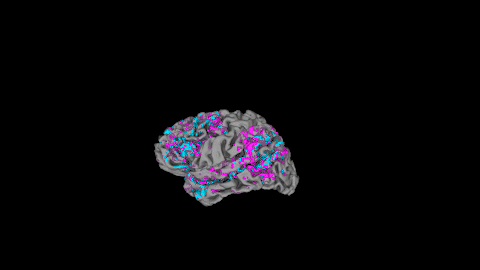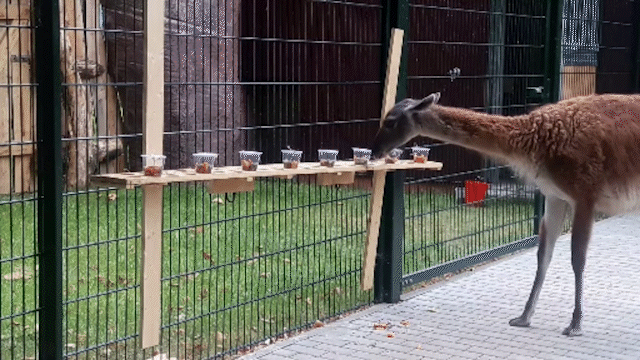New Research
This Trove of Fossils in Wales Is Revealing Secrets of Early Animal Life
Scientists have uncovered 170 species from around 462 million years ago, unveiling surprises about when tiny marine creatures evolved and disappeared
Researchers Use A.I. to Decode Words From Brain Scans
A new tool translates "something deeper than language," generating text that captures the gist of podcasts or silent films viewed by participants
Balto's DNA Provides a New Look at the Intrepid Sled Dog
Scientists sequenced the famous canine's genome as part of a larger project studying the genes of 240 mammal species
First-of-Its-Kind Image Captures a Black Hole's Shooting Jet
The finding could help reveal how black holes launch such high-energy ejections
Great Apes Love to Spin Around—Here's Why
A recent study suggests that apes, like humans, seek out altered mental states
This 39,600-Year-Old Bone May Have Been Used by Prehistoric Tailors
New research suggests early Homo sapiens punched holes in leather hides to create seams for clothing
The Pacific Garbage Patch Is Home to Coastal Species—in the Middle of the Ocean
These out-of-place organisms are thriving on floating trash, but they may compete with open-water species
Elephant Seals Take Extreme Power Naps in the Open Ocean
While foraging on deep dives, the marine mammals sleep for about two hours per day in short, ten-minute bursts
Researchers Find Hidden Markings on the Stone of Destiny, Sacred Slab Used in British Coronations
Ahead of the crowning of Charles III on May 6, experts analyzed the stone with cutting-edge technology
Scientists Taught Pet Parrots to Video Call Each Other—and the Birds Loved It
Wild parrots tend to fly in flocks, but when kept as single pets, they may become lonely and bored
Carnivorous Plants May Lure Insects With Specially Tailored Scents
Pitcher plants appear to use different odor cocktails to attract bees, moths, ants and other bugs into their death traps
Lizard Remains Found Inside 2,500-Year-Old Coffins from Ancient Egypt
Researchers at the British Museum used neutron tomography to get a look inside the still-sealed metal boxes without damaging the artifacts
Scientists Update Map of How Our Brains Control Movement
The traditional diagram showed brain regions linked to specific body parts, but we might also have areas connected to whole-body control
Outsider Animals May Be the Best at Solving Problems
Researchers tested whether hoofed mammals could retrieve food from a lidded cup, and those lower in the pecking order were the most successful
Cache of Ancient Severed Hands May Have Been Part of a Ritual
Twelve right hands found in an Egyptian palace courtyard were likely battle trophies that warriors exchanged for gold
Why Lake Tahoe Is the Clearest It's Been in 40 Years
Thanks to a "natural clean-up crew" of zooplankton, the large freshwater alpine lake is looking especially pristine
New mRNA Vaccine Shows Promise Against Skin Cancer
Research suggests the personalized vaccine, paired with an immunotherapy drug, can reduce melanoma recurrence in high-risk patients
How Life Could Have Survived the Frozen ‘Snowball Earth’
During a prehistoric ice age when the planet was enveloped in glaciers, algae could have made a living in patchy, open oceans, study suggests
See the Sharp New Image of a Supermassive Black Hole
Astronomers used machine-learning technology to improve a 2019 visualization of the M87 black hole, located some 54 million light-years away from Earth
Wealthy Residents' Pools and Gardens Are Driving Water Crises
Urban elites use a disproportionate share of water compared to their lower-income peers, according to a new study
Page 34 of 254
:focal(1081x762:1082x763)/https://tf-cmsv2-smithsonianmag-media.s3.amazonaws.com/filer_public/80/d2/80d28690-b27c-4180-bd0a-c5f69063e729/cambrian.jpeg)

:focal(1903x1196:1904x1197)/https://tf-cmsv2-smithsonianmag-media.s3.amazonaws.com/filer_public/79/bc/79bc20b0-a61d-4a40-9548-71e825ae449d/gettyimages-514699710.jpg)
:focal(640x500:641x501)/https://tf-cmsv2-smithsonianmag-media.s3.amazonaws.com/filer_public/46/0b/460bd2f8-4ee2-43a7-af3f-39d46f9d3901/eso2305a.jpeg)
:focal(1500x1000:1501x1001)/https://tf-cmsv2-smithsonianmag-media.s3.amazonaws.com/filer_public/0e/69/0e690db9-8e69-41c7-990a-be0d61e09fc1/gettyimages-510754662.jpg)
:focal(1050x840:1051x841)/https://tf-cmsv2-smithsonianmag-media.s3.amazonaws.com/filer_public/20/fe/20fe5f9d-bc77-4d36-a69f-d728814c794b/sciadvadg0834-f2.jpg)
:focal(1061x707:1062x708)/https://tf-cmsv2-smithsonianmag-media.s3.amazonaws.com/filer_public/1b/5e/1b5e01af-2b07-45ff-8dde-6dda1dab5d99/gettyimages-108870993.jpg)
:focal(600x314:601x315)/https://tf-cmsv2-smithsonianmag-media.s3.amazonaws.com/filer_public/a4/57/a4576740-eae0-49be-8136-9e1e85b8c2d0/01_sleepingseals03_jessica-kendall-bar-ucsd-lead.png)
:focal(1271x815:1272x816)/https://tf-cmsv2-smithsonianmag-media.s3.amazonaws.com/filer_public/a5/2d/a52d0fd2-b657-4233-9c17-7c53f660545b/screenshot_2023-04-24_at_50229_pm.png)
:focal(550x367:551x368)/https://tf-cmsv2-smithsonianmag-media.s3.amazonaws.com/filer_public/4d/41/4d41f1fa-3381-4618-b9fd-fd9b9be9dbda/041023_mm_jennifer_cunha_012.jpg)
:focal(526x255:527x256)/https://tf-cmsv2-smithsonianmag-media.s3.amazonaws.com/filer_public/1e/fb/1efbbb21-0add-49e9-bb3b-ac422d2a6a85/photo-4-sarracenia-pitchers.png)
:focal(1440x1001:1441x1002)/https://tf-cmsv2-smithsonianmag-media.s3.amazonaws.com/filer_public/37/7e/377e0e86-1ce4-4f16-a1a4-77817c5342bc/insights-into-sealed-a.jpeg)
:focal(2128x1419:2129x1420)/https://tf-cmsv2-smithsonianmag-media.s3.amazonaws.com/filer_public/2a/e3/2ae32958-69bf-4a7d-b549-213b6d03caed/gettyimages-143170371.jpg)

:focal(632x928:633x929)/https://tf-cmsv2-smithsonianmag-media.s3.amazonaws.com/filer_public/7f/c8/7fc8d5d4-c271-4870-b309-abb5671413b4/gesamtsicht_von_11_rechten_handen_die_im_vorhof_des_thronssaals_gefunden_wurden.jpg)
:focal(2016x1517:2017x1518)/https://tf-cmsv2-smithsonianmag-media.s3.amazonaws.com/filer_public/5c/94/5c9480e0-2a5b-46e5-8441-f2957b315cc7/tahoe_blue_ice_brant_allen_uc_davis_terc.jpg)
:focal(1060x717:1061x718)/https://tf-cmsv2-smithsonianmag-media.s3.amazonaws.com/filer_public/d0/66/d066bf2e-64ae-4c51-8e29-d40b26c5c5b0/gettyimages-1209284023.jpg)
:focal(450x257:451x258)/https://tf-cmsv2-smithsonianmag-media.s3.amazonaws.com/filer_public/32/16/3216f4c9-4a61-4a1e-a811-d4ea298d7d9d/image_1.jpeg)
:focal(288x288:289x289)/https://tf-cmsv2-smithsonianmag-media.s3.amazonaws.com/filer_public/c6/47/c647b94c-ad81-48ab-a705-577a3c14c866/m87_primo_single_bw8_no_scale_5000px.jpg)
:focal(960x645:961x646)/https://tf-cmsv2-smithsonianmag-media.s3.amazonaws.com/filer_public/c6/b6/c6b6203d-806f-43c5-9e0f-8243dc68a74c/pool-gf67cdebdc_1920.jpg)